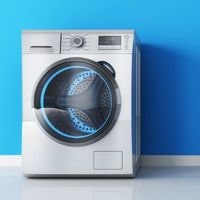How To Balance A Washing Machine. If your washer begins to make an excessive amount of noise, it could mean that something is a little off-kilter with the machine itself.
Be mindful of the fact that even your average home unit might not be installed in a way conducive to smooth operations. Every machine requires that you adjust the overall load consistently by either making additional room or fine-tuning its position.
An unbalanced washer does not clean or drain clothes properly and will eventually damage crucial components internally if left alone without maintenance. Balancing or rebalancing your washer also helps prevent damage to the machine and extends its life as well.
How To Balance A Washing Machine
How To Balance A Washing Machine. If your washer is up on a pedestal, there are two ways to level it: Adjust the feet on the back legs of a top-loading model or turn one of the legs on a front-loading machine.
Always point the feet in the direction of the slope if that doesn’t work, try moving them in an opposing direction to shift the balance.
Washing Machine Vibration Fix
While the majority of washers experience this issue, both top loaders and front loaders may vibrate and make noise if there is a load imbalance or if appliances are not properly leveled.
If the load isn’t distributed evenly instead of being piled up on one side of the tub, towels, sheets, or blankets can bunch in a clump, and then as soon as you spin, all that fabric catches together, causing a big vibration. It’s all about that centrifugal force.
All of this shaking can cause the inner tub to rub against the side of the outer tub ring, causing an unpleasant sound to resonate through your house.
To prevent this from happening, pick loads with similar-sized items rather than balling up large rugs or comforters.
Make sure that each time you wash something, you either share it out between multiple loads or re-balance weight distribution by removing items that may have shifted around since washing last and then adding new ones.
Bubble Level Setting
One of the best ways to tell if your dishwasher is properly leveled or not is to set a bubble level across the top panel of the washer near the front edge.
If the height of the washer is the same on both the left and right sides, the bubble will rest directly between the two middle lines if the bubble comes to rest anywhere to the left of the two middle lines.
Then your dishwasher isn’t properly leveled on that side; if it rests to the right, then it’s improperly leveled on that side.
It may seem like a pain now but don’t worry! In this article, you’ll read about how leveling your dishwasher correctly is always worth it in terms of not only improving your energy efficiency but also in regards to prolonging its longevity.
Objects Beneath The Washer
Make sure to check for obvious reasons that your machine might be off-balance. It might be as simple as removing a foreign object from underneath it.
Some machines have “packaging support” underneath the machine that needs to be removed prior to installation. A front-load washer comes with packaging support that “fits up into the machine and nestles against the bottom of the tub”.
If it’s not removed, your washer will vibrate excessively and could come off balance. Finally, check for any foreign objects underneath the feet of the machine.
Overload Issue
The most common mistake people make when cleaning their clothes is filling the washing machine too full, then adding extra clothing and other items on top of what already filled the reservoir.
This will only clog up your washer filler tube, which may result in decreased sudsing action.
Brownie Points for always filling your washer’s drum with enough water to flush out any dirt or grime through the tub drain hose but no more than 8 inches of water, depending on your model’s design.
It’s also a good idea to empty a soapy washer before you start a rinse cycle to make sure that any leftover soap doesn’t interfere with rinsing actions.
Internal Damage Problem
Parts like belts, bolts, screws, and bearings can make a washing machine work properly. These elements function as part of the balancing mechanism of the unit and ensure that once on track, it completes its cycle.
Even one part failing to do its job will cause the entire apparatus to malfunction in such a way that your laundry won’t get cleaned.
A sign of something being wrong is an off-balanced unit hesitating in its rotation or stopping after completing part of its cycle.
How To Balance A Washing Machine
Related Guides
